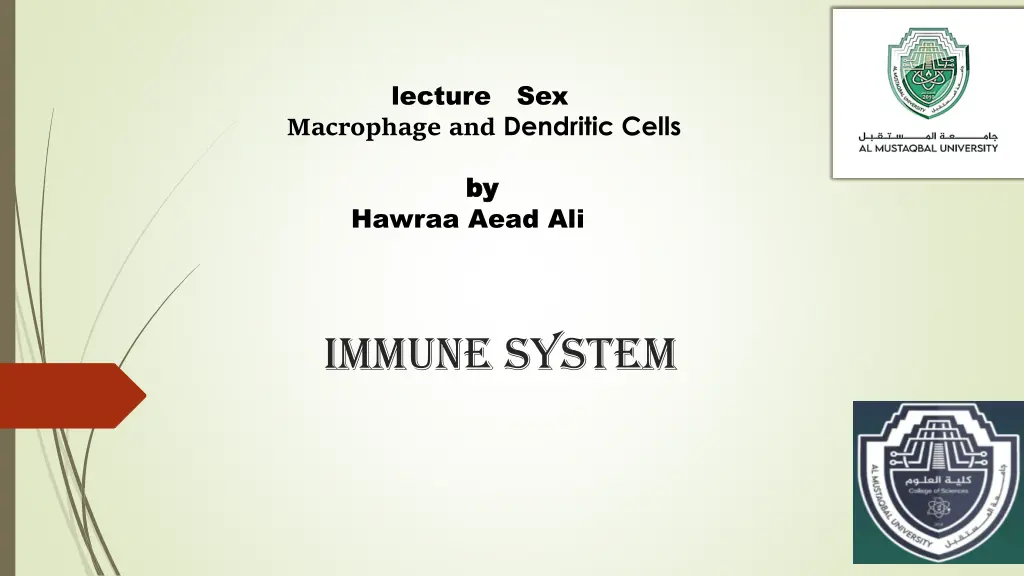
Understanding the Role of Macrophages in the Immune System
Learn about the essential functions of macrophages in the immune system, including phagocytosis, immune response activation, inflammation regulation, tissue repair, and antigen presentation. Explore the process of phagocytosis in macrophages and how they play a vital role in maintaining tissue health and immune balance.
Download Presentation

Please find below an Image/Link to download the presentation.
The content on the website is provided AS IS for your information and personal use only. It may not be sold, licensed, or shared on other websites without obtaining consent from the author. If you encounter any issues during the download, it is possible that the publisher has removed the file from their server.
You are allowed to download the files provided on this website for personal or commercial use, subject to the condition that they are used lawfully. All files are the property of their respective owners.
The content on the website is provided AS IS for your information and personal use only. It may not be sold, licensed, or shared on other websites without obtaining consent from the author.
E N D
Presentation Transcript
lecture Sex Macrophage and Dendritic Cells by by Hawraa Aead Ali IMMUNE SYSTEM
Macrophages Macrophages are a type of white blood cell that play a crucial role in the immune system. Their main functions include: 1.Phagocytosis (Engulfing Pathogens & Debris) 1. Macrophages engulf and digest pathogens, dead cells, and cellular debris to keep tissues clean and free from infections. 2.Immune Response Activation 1. They act as antigen-presenting cells (APCs), displaying pieces of pathogens (antigens) to helper T cells, which triggers an adaptive immune response.
3- Inflammation Regulation Macrophages release cytokines and chemokines to recruit other immune cells to sites of infection or injury, promoting inflammation. 4- Tissue Repair and Healing After an infection or injury, macrophages help in tissue repair by releasing growth factors and anti-inflammatory signals to support healing. 5- Surveillance and Homeostasis They constantly patrol tissues, removing dead cells and maintaining balance in the body's immune environment.
Phagocytosis Phagocytosis in Macrophages (Engulfing Pathogens & Debris) Phagocytosis is the process by which macrophages engulf and digest harmful microorganisms, dead cells, and cellular debris. It is a key part of the innate immune response. The process occurs in several steps: 1. Recognition and Attachment Macrophages recognize pathogens or debris using pattern recognition receptors (PRRs) such as Toll-like receptors (TLRs) and complement receptors. Opsonization enhances recognition opsonins (e.g., antibodies or complement proteins) coat pathogens, making them easier to detect. 2. Engulfment (Ingestion) The macrophage extends its plasma membrane around the pathogen using cytoplasmic projections called pseudopodia. The pathogen is fully enclosed in a vesicle called a phagosome inside the macrophage.
3. Fusion with Lysosome (Phagolysosome Formation) The phagosome fuses with a lysosome, forming a phagolysosome. Lysosomes contain digestive enzymes (e.g., lysozymes, proteases, and hydrolases) that help break down the pathogen. 4. Digestion and Destruction The pathogen is broken down into small fragments by enzymes and reactive oxygen species (ROS) like hydrogen peroxide and nitric oxide. The degraded material is either used by the macrophage or expelled as waste.
5. Antigen Presentation (If Needed) Some fragments of pathogens (antigens) are displayed on the macrophage s MHC class II molecules to activate helper T cells. This helps initiate the adaptive immune response for long-term immunity. 6. Waste Removal Indigestible materials are expelled from the macrophage via exocytosis.
Dendritic Cells Dendritic cells (DCs) are professional antigen- presenting cells (APCs) that serve as a crucial link between the innate and adaptive immune systems. Their main function is to detect pathogens, process their antigens, and activate T cells to initiate an immune response.
Key Functions of Dendritic Cells 1. Antigen Capture (Pathogen Detection) Dendritic cells are found in tissues that are in contact with the external environment (e.g., skin, lungs, and intestines). They use pattern recognition receptors (PRRs) such as Toll-like receptors (TLRs) to recognize pathogen- associated molecular patterns (PAMPs) on bacteria, viruses, and fungi. Once they detect a pathogen, they engulf it through phagocytosis, macropinocytosis, or receptor-mediated endocytosis.
2. Antigen Processing and Presentation After engulfing pathogens, dendritic cells digest them into smaller fragments (antigens). These antigens are then displayed on major histocompatibility complex (MHC) molecules: MHC class I presents antigens to CD8+ cytotoxic T cells, which kill infected cells. MHC class II presents antigens to CD4+ helper T cells, which coordinate the immune response. 3. Migration to Lymph Nodes Once they capture an antigen, dendritic cells undergo maturation and migrate to nearby lymph nodes. In the lymph nodes, they interact with na ve T cells, providing signals that activate them and initiate an adaptive immune response.
4. T Cell Activation and Immune Response Regulation Dendritic cells provide three key signals to activate T cells: Antigen Presentation (via MHC molecules). Co-stimulatory Signals (via molecules like CD80/CD86 binding to CD28 on T cells). Cytokine Release (to shape the type of immune response, e.g., pro-inflammatory or anti-inflammatory). Depending on the situation, they can stimulate: CD8+ cytotoxic T cells to destroy infected cells. CD4+ helper T cells to recruit other immune cells (macrophages, B cells). Regulatory T cells (Tregs) to suppress excessive immune responses and prevent autoimmunity.
5. Inducing B Cell Activation and Antibody Production Dendritic cells help activate B cells, which then produce antibodies to neutralize pathogens. 6. Immune Tolerance and Autoimmune Prevention In the absence of infection, dendritic cells help maintain immune tolerance by presenting self-antigens to prevent the activation of self-reactive T cells. This prevents autoimmune diseases by teaching the immune system to ignore harmless self-tissues.






















